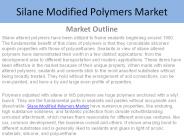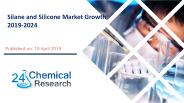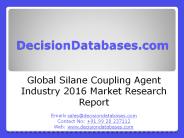Silane PowerPoint PPT Presentations
All Time
Recommended
Silanes are saturated hydrosilicons, which include silicon and hydrogen, carbon, and nitrogen atoms. It comprises a homologous series of inorganic compounds that are synthetically derived for commercial purposes.
| PowerPoint PPT presentation | free to download
2020 Analysis and Review: Silanes Market by Application – Rubber, Adhesives & Sealants, Fiberglass and Composites, Paint, Ink & Coatings, Electronics, Mineral and Filler Treatment, and Surface Protection for 2020-2030
| PowerPoint PPT presentation | free to download
A recent report published by Precision Business Insights on Silane Market provides in-depth analysis of segments and sub-segments in the global as well as regional.
| PowerPoint PPT presentation | free to download
Silane Market is forecast to reach $2.1 billion by 2025, after growing at a CAGR of 5.3% during 2020-2025. Anticorrosion properties of silanes make it an outstanding material for protective coating purposes in a wide variety of applications
| PowerPoint PPT presentation | free to download
Silane Market is forecast to reach $2.1 billion by 2025, after growing at a CAGR of 5.3% during 2020-2025
| PowerPoint PPT presentation | free to download
According to the latest research report by IMARC Group, The global silane market size reached US$ 1.9 Billion in 2023. Looking forward, IMARC Group expects the market to reach US$ 2.9 Billion by 2032, exhibiting a growth rate (CAGR) of 4.2% during 2024-2032. More Info:- https://www.imarcgroup.com/silane-market
| PowerPoint PPT presentation | free to download
Global Silanes Market accounted for USD 1.40 billion in 2016 and is projected to grow at a CAGR of 6.0% during the forecast period of 2017 to 2024. The upcoming market report contains data for historic years 2014, 2015, the base year of calculation is 2016 and the forecast period is 2017 to 2024.
| PowerPoint PPT presentation | free to download
Silane Modified Polymers Market: By Type, By Application and Region - Forecast 2027
| PowerPoint PPT presentation | free to download
The global silane market reached a value of US$ 1.76 Billion in 2021. Looking forward, IMARC Group expects the market to reach US$ 2.35 Billion by 2027, exhibiting at a CAGR of 5.22% during 2022-2027. More info:- https://www.imarcgroup.com/silane-market
| PowerPoint PPT presentation | free to download
According to the latest research report by IMARC Group, The global silane market size reached US$ 1.9 Billion in 2022. Looking forward, IMARC Group expects the market to reach US$ 2.5 Billion by 2028, exhibiting a growth rate (CAGR) of 5% during 2023-2028. More Info:- https://www.imarcgroup.com/silane-market
| PowerPoint PPT presentation | free to download
Download free PDF Sample: http://bit.ly/2rQh9UU #EpoxySilanes #MarketAnalysis The global Epoxy Silanes market was valued at million US$ in 2018 and will reach million US$ by the end of 2025
| PowerPoint PPT presentation | free to download
The global Silane Modified Polyethers market is valued at US$ xx million in 2020 is expected to reach US$ xx million by the end of 2026, growing at a CAGR of xx% during 2021-2026.
| PowerPoint PPT presentation | free to download
Download FREE Sample Report- http://bit.ly/2vdpDn7 Silanes are monomeric silicon compounds with four substituents, or groups, attached to the silicon atom. These groups can be the same or different and nonreactive or reactive, with the reactivity being inorganic or organic. Inorganic reactive silanes have alkoxysilane groups and undergo hydrolytic polycondensation reactions. Organic reactive silanes contain amine, vinyl, epoxy, isocyanate or other functional groups that enable reactions with organic functionalities. for more visit here- http://bit.ly/2Dlgopf
| PowerPoint PPT presentation | free to download
Epoxy Silanes market is segmented by region (country), players, by Type, and by Application. Players, stakeholders, and other participants in the global Epoxy Silanes market will be able to gain the upper hand as they use the report as a powerful resource. The segmental analysis focuses on revenue and forecast by region (country), by Type and by Application in terms of revenue and forecast for the period 2016-2027.
| PowerPoint PPT presentation | free to download
The global silane market reached a value of US$ 1.76 Billion in 2021. Looking forward, IMARC Group expects the market to reach US$ 2.35 Billion by 2027, exhibiting at a CAGR of 5.22% during 2022-2027. More info:- https://www.imarcgroup.com/silane-market
| PowerPoint PPT presentation | free to download
DecisionDatabases.com adds a report on Global Silane Coupling Agent Industry 2016 Market Research Report. This research study is segmented on the bases of applications, technology and geography.
| PowerPoint PPT presentation | free to download
More Information @ https://bit.ly/2RZ5B9P Silanes market size for fiber glass & mineral wool is likely to grow at a CAGR close to 8% in the coming years. Product are widely applicable as adhesion promoter in fiber glass & mineral wool, which are widely used as an insulation material across several end-user industries such as construction, automotive, plastic packaging, etc.
| PowerPoint PPT presentation | free to download
Silane Market by Type (Organo-functional Silane, Mono/Chloro Silane), by Application (Rubber & Plastics, Fiber Treatment, Adhesives & Sealants, Paint and Coatings, and others) - Global Forecasts to 2020
| PowerPoint PPT presentation | free to download
The Silane Coupling Agents Market Report offers a complete picture of industry trends and factors along with quantitative data based on historical data and from various sources. Apart from this, the report also provides the market outlook, growth, share, size, opportunity and forecast during 2019-2025. Further, the report focuses on competitive landscape including company profiles of leading key players along with industry demand, future capacities, key mergers & acquisitions, financial overview in the global market of silane coupling agents.
| PowerPoint PPT presentation | free to download
Silanes market growth in the global market especially in paints and coatings industry, because of its inability to withstand static pressure.
| PowerPoint PPT presentation | free to download
Antimicrobial Fabric Conditioner that keeps your clothes germ free for up to 20 washes. Specially formulated for use in offices, restaurants, health care facilities, schools, shopping malls, marketplaces and On Premise Laundries (OPL).
| PowerPoint PPT presentation | free to download
Project studied the effect of ventilation on the ignition characteristics of ... of about 1.4%. This agrees with published values of the LFL of silane ...
| PowerPoint PPT presentation | free to view
The Global Silanes Market accounted for USD 1.40 billion in 2016 and is projected to grow at a CAGR of 6.0% during the forecast period of 2017 to 2024. The upcoming market report contains data for historic years 2014, 2015, the base year of calculation is 2016 and the forecast period is 2017 to 2024.
| PowerPoint PPT presentation | free to download
Global Silanes and Silicones Market is expected to grow from its initial estimated value of USD 15.48 billion in 2018 to an estimated value of USD 26.16 billion by 2026, registering a CAGR of 6.78% in the forecast period of 2019-2026. This rise in market value can be factored to the growth in demand of the products from various end-users that have been a result of their own respective market value growth.
| PowerPoint PPT presentation | free to download
Global Silanes and Silicones Market Information Report by Type, Silane Application, Silicone Application and by Regions Forecast to 2023
| PowerPoint PPT presentation | free to download
Mass spectrometer works (most of the time ... Electrometer. Rect. Pressure. Labview. Problems with the electron gun. The current arriving to the ...
| PowerPoint PPT presentation | free to view
A recent market study published by FMI on the Silanes market includes global industry analysis 2015-2019 & opportunity assessment 2020-2030, and delivers a comprehensive assessment of the market dynamics.
| PowerPoint PPT presentation | free to download
Antimicrobial agents are used to kill or limit growth of microorganisms. GIS Microbe Shield , an antimicrobial agent composed of a silane quaternary ...
| PowerPoint PPT presentation | free to view
... commercial production environments. One of these is the production of solar cells. ... Solar cells are known to have a high cost and a poor efficiency. ...
| PowerPoint PPT presentation | free to download
... 50mL aliquots of the diluted bacteria were distributed into sterile 250mL flasks. ... The nine flasks were agitated in a reciprocal shaker at 120 RPM. ...
| PowerPoint PPT presentation | free to view
... The charring model Resin systems Phenolics Phenyl silanes Nitrile phenolics Nitrile rubber Silicones Epoxy polyamide Novolac epoxies Abrative fillers ...
| PowerPoint PPT presentation | free to view
Why would silanes be so much less stable than alkanes? Bond Energies, kJ/mol: ... Zeolites and Catalysis. Purpose of a catalyst: increase rate, selectivity ...
| PowerPoint PPT presentation | free to download
Silicone Family Tree Si Volatile Methyl Siloxanes Silicone Polyethers Silanes Fluids & Emulsions Silicone Resins Dimethyl Compounds Organo-Silicones Amino ...
| PowerPoint PPT presentation | free to view
2. Surface treatments (ITT, Silane, Crosspolymer, Perfluoroalkyl phosphate, ... Smooth and glossy. Uneven and low color strength. Appearance. www.koboproducts.com ...
| PowerPoint PPT presentation | free to view
La Porta, Lopez-de-Silanes & Shleifer JF 1999 ... Fiat, 3th most valuable, Giovanni Agnelli Family ultimate owner, pyramid, dual shares ...
| PowerPoint PPT presentation | free to view
GOVERNMENT OWNERSHIP OF BANKS AND BANKING REGULATION Florencio Lopez-de-Silanes IADB Conference, Washington, DC. February 25, 2005. Motivation There is mounting ...
| PowerPoint PPT presentation | free to view
Global Elastomeric Sealants Market Information: By Type (Silicone, Polysulfide, Polyurethane, Silane Modified Polymers), End-Use Industries (Building & Construction, Automotive, Electronics, Woodworking, Aerospace & Defense, Marine) And Region- Forecast Till 2023
| PowerPoint PPT presentation | free to download
Olefin Polymerizations Catalyzed by Late Transition Metal Complexes Maurice Brookhart University of North Carolina Ethylene / Alkoxy Vinyl Silane Copolymers Versipol ...
| PowerPoint PPT presentation | free to view
Glass-Ceramic: polycrystalline material formed as a glass and then crystallized ... Feed in hydrocarbon, silane carbide, and inert gases ...
| PowerPoint PPT presentation | free to download
Free Research Report PDF: https://bit.ly/2AXUoCq The hydrophobic coating is made of modified silane nanomaterials, and the contact angle is greater than 150 °. Due to the extremely low tension of the coating surface, the contact area of water and dirt with the coating surface is greatly reduced Download Free Research Report PDF: https://bit.ly/2MJSGXZ
| PowerPoint PPT presentation | free to download
Global Elastomeric Sealants Market Research Report: Information by Type (Silicone, Polysulfide, Polyurethane, Silane Modified Polymers, and Others), End-Use Industry (Building & Construction, Automotive, Electrical & Electronics, Aerospace & Defense, Marine, and Others), Region (North America, Asia-Pacific, Europe, Latin America, and Middle East & Africa)—Forecast till 2025
| PowerPoint PPT presentation | free to download
'There hasn't been a brand as of yet to introduce a color cosmetic line that uses ... Metal Soaps, Silicones & Silanes, Titanates. NOT NATURAL ! www.koboproducts.com ...
| PowerPoint PPT presentation | free to view
WHY DOES FRESH NUCLEATION OCCUR IN A DUSTY PLASMA VOID? Numerical model self-consistently couples plasma, chemistry & aerosol for capacitively-coupled RF argon-silane ...
| PowerPoint PPT presentation | free to download
To illustrate, I would like to draw your attention to two inputs that we can all ... Silane gas ignites on contact with air and has engulfed workers in flames. ...
| PowerPoint PPT presentation | free to view
Download free PDF Sample@ https://bit.ly/3gq0VGx #ChemicalsAndMaterials #Chemicals #MarketAnalysis #Dichloromethylvinylsilane Dichloromethylvinylsilane (CAS 124-70-9) is an organic silicon substance containing alkyl sidechains. It is a corrosive, moderately volatile and highly flammable liquid with a low boiling point. It is also used as a monomer (building block) in the production of silicone polymers and as an intermediate (starting material) in the production of other organosilicon substances.Dichloro(methyl)(vinyl)silane is a corrosive, moderately volatile and highly flammable liquid with a low boiling point. It reacts violently with water, rapidly breaking down to methyl(vinyl)silanediol and hydrochloric acid.
| PowerPoint PPT presentation | free to download
"Sculpt, a universal sculptable composite with advanced light scattering technology that merges GC’s innovative single dispersion nano-fillers. Sculpt is a material that clinicians can place with ease for beautifully adapted, finished, fast, aesthetic and tough composite restorations. 1. With improved wear resistance, handling and operability, Sculpt can be used for anterior and posterior restorations, composite veneers, diastema closures, and composite/porcelain repairs. 2. Sculpt has a unique homogeneous, pre-polymerised nano-fillers with high density & uniform dispersion silane treatment technology similar to G-aenial Universal Flo. 3. 300-nm strontium glass fillers homogeneously dispersed for high flexural strength and wear resistance."
| PowerPoint PPT presentation | free to download
It is an anti-microbial agent imparts durable, broad spectrum, bio-static activity to the surface of a wide variety of substrates. It is leach resistant & non-migrating & is not consumed by microorganisms. Effective against gram positive & gram negative bacteria, fungi, algae & yeast’s. Silane quaternary ammonium compound.
| PowerPoint PPT presentation | free to view
Silicon tetrachloride is the inorganic compound with the formula SiCl4. It is a colourless volatile liquid that fumes in air. It is used to produce high purity silicon and silica for commercial applications. Silicon tetrachloride is used as an intermediate in the manufacture of polysilicon, a hyper pure form of silicon, since it has a boiling point convenient for purification by repeated fractional distillation. It is reduced to trichlorosilane (HSiCl3) by hydrogen gas in a hydrogenation reactor, and either directly used in the Siemens process or further reduced to silane (SiH4) and injected into a fluidized bed reactor. Silicon tetrachloride reappears in both these two processes as a by-product and is recycled in the hydrogenation reactor. The produced polysilicon is used as wafers in large amounts by the photovoltaic industry for conventional solar cells made of crystalline silicon and also by the semiconductor industry.
Silicon tetrachloride is the inorganic compound with the formula SiCl4. It is a colourless volatile liquid that fumes in air. It is used to produce high purity silicon and silica for commercial applications. Silicon tetrachloride is used as an intermediate in the manufacture of polysilicon, a hyper pure form of silicon, since it has a boiling point convenient for purification by repeated fractional distillation. It is reduced to trichlorosilane (HSiCl3) by hydrogen gas in a hydrogenation reactor, and either directly used in the Siemens process or further reduced to silane (SiH4) and injected into a fluidized bed reactor. Silicon tetrachloride reappears in both these two processes as a by-product and is recycled in the hydrogenation reactor. The produced polysilicon is used as wafers in large amounts by the photovoltaic industry for conventional solar cells made of crystalline silicon and also by the semiconductor industry.
Creative PEGWorks has been the leading PEG supplier in the US and world since 2007. Our main product lines include activated PEGs, reactive PEG derivatives and PEGylation reagents. We manufacture a unique variety of functional synthetic polymers and biopolymers also including polysaccharides, hyaluronic acid, PEGylated copolymers (block and graft) and biodegradable polymers.
| PowerPoint PPT presentation | free to download
ISO 18184 is a ISO certified test method used to determine the antiviral activity of textile products against viruses Get a Quote today!
| PowerPoint PPT presentation | free to download
The Business Research Company offers concrete sealer market research report 2023 with industry size, share, segments and market growth
| PowerPoint PPT presentation | free to download
Marc L. Rothstein and Dianne M. Rothstein Prime Synthesis, Inc. Aston, PA 19014 Once the best low-cost CNA linker was identified by the screening test, it was ...
| PowerPoint PPT presentation | free to download
Aston, PA 19014. The prices for phosphoramidite monomers and other synthesis chemicals have ... also like to thank Trey Martin, Mike Marvin and Dr. Yakov ...
| PowerPoint PPT presentation | free to download
Title: PowerPoint Presentation Author: Ankur Agarwal Last modified by: Mark J. Kushner Created Date: 11/8/2004 9:33:55 PM Document presentation format
| PowerPoint PPT presentation | free to download
Zirconia Alumina Metal Primer BISCO s Z-PRIME Plus is a single-component priming agent used to create adhesion between indirect restorative materials and ...
| PowerPoint PPT presentation | free to view
























































